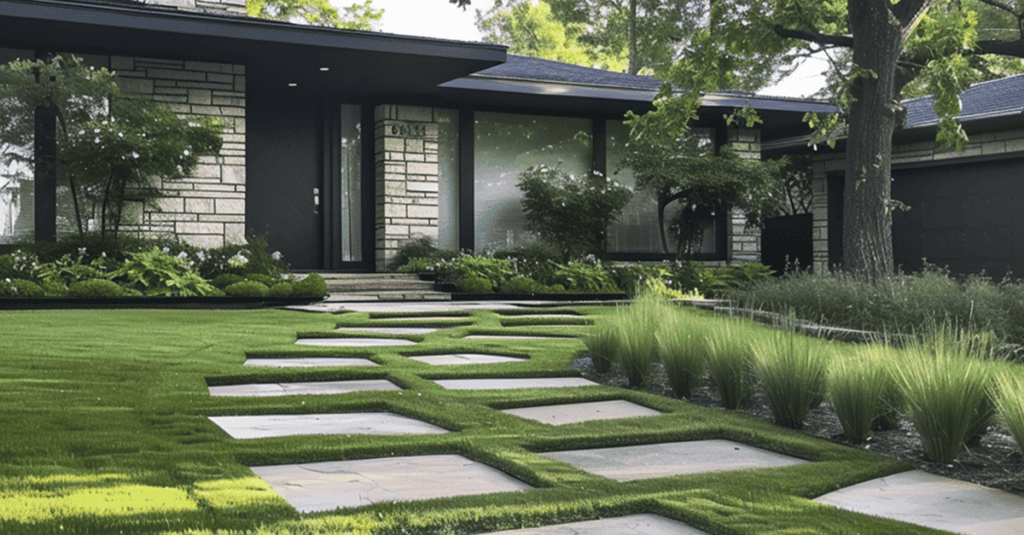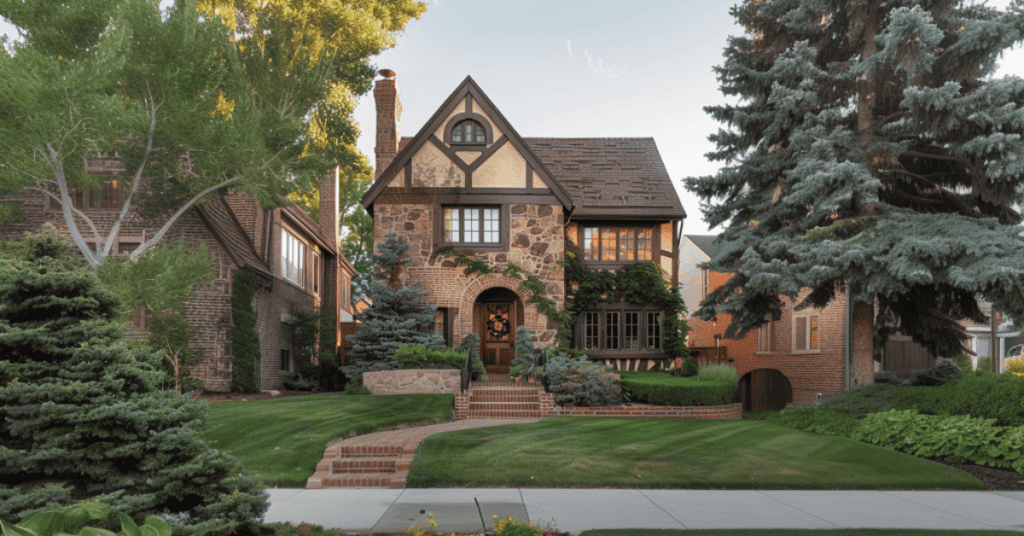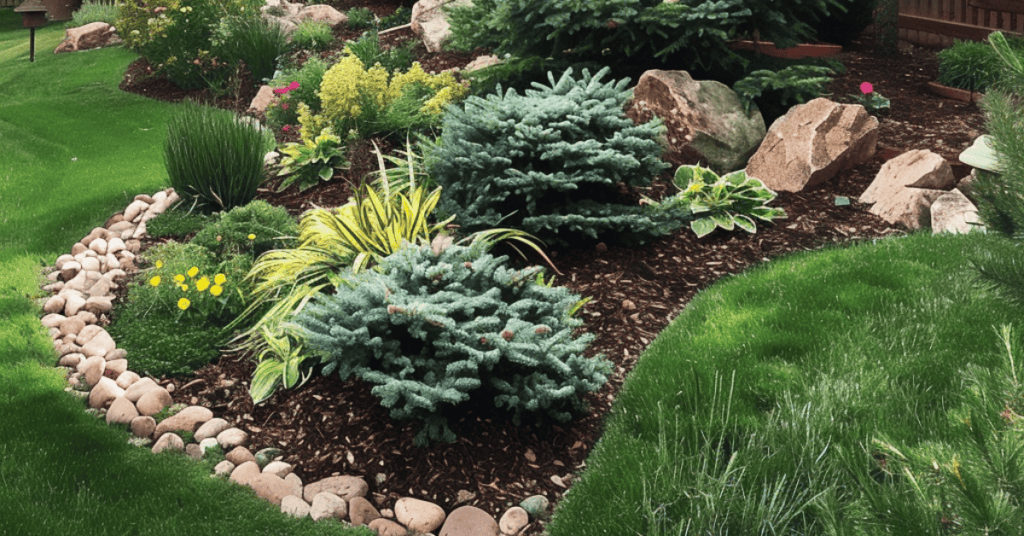Block Weeds and Control Erosion in Planting Areas
Ground cover refers to low-growing plants that spread and cover the ground. These plants are often used in landscape design to create a uniform look and help with soil erosion. Ground cover plants can include both ornamental and functional varieties.
A ground cover plant can come in various types, including herbaceous and woody species. They can be annuals, biennials, or even a perennial plant. For instance, perennial groundcover plants like creeping phlox create a long-lasting effect in gardens.
Here in Denver and along Colorado’s Front Range, you’ll oftentimes find drought tolerant native plants used in xeriscaping applications due to their low water requirements and ability to thrive in their native environment.
Benefits of Using Ground Cover
- Erosion Control: Ground cover helps prevent soil erosion by stabilizing the soil with their roots.
- Weed Suppression: These plants reduce weed growth by covering the soil and blocking light.
- Low Maintenance: Once established, many ground covers require minimal care.
- Temperature Control: Similar to organic mulch, ground cover does a good job of keeping the soil temperature at an appropriate level as it shields much of the soil from direct sunlight.
Benefits of Ground Cover Plants
Erosion Control
Ground cover landscape plants play a crucial role in controlling erosion. Their roots hold the soil in place, reducing runoff and soil loss during rainstorms. This is especially useful on slopes and in areas prone to heavy rainfall.
Plants like ivy and creeping junipers can effectively anchor the soil. This minimizes the need for additional erosion control measures. By covering bare ground, they protect the soil surface from being washed away. This natural method of erosion control is both sustainable and visually pleasing, making it a valuable landscaping solution.
Weed Suppression
Ground cover plants are excellent for suppressing weeds. Their dense foliage blocks sunlight, making it hard for weed seeds to germinate. This reduces the need for chemical weed killers. Plants like vinca minor (Periwinkle) spread quickly, forming a thick mat that outcompetes weeds for resources.
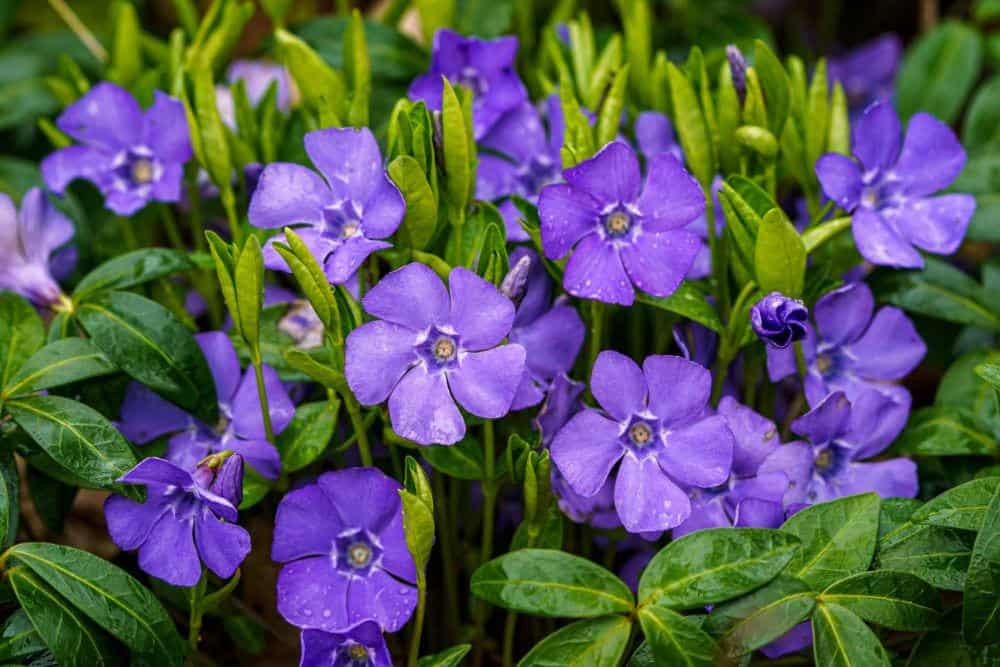
The Beautiful Lavender Flowers of Periwinkle (Vinca)
Using these plants can save time and effort in garden maintenance. Weed suppression through ground cover plants also promotes healthier soil. This is because it reduces the disturbance that comes with frequent weeding.
Aesthetic Appeal
Ground cover plants add a colorful and attractive element to landscapes. They come in various colors, textures, and heights. This variety helps create visual interest and contrast in garden design.
For instance, the bright flowers of creeping thyme bring vibrant colors while the leaves of pachysandra offer a lush green carpet. Ground covers can also fill in gaps between larger plants, making the landscape look more cohesive.
Environmental Advantages
Ground cover plants provide several environmental benefits. They create habitats for beneficial insects and pollinators, contributing to a healthier ecosystem. These plants also improve soil by adding organic matter as they grow and decompose.
Being low maintenance, they require less water, fertilizer, and pesticides than traditional turf grass. This results in less time devoted to lawn care and it also makes them a sustainable choice for eco-friendly gardening. Additionally, their ability to retain moisture in the soil helps reduce water usage. Ground covers are a smart option for those looking to make environmentally conscious landscaping choices.
Selection Criteria for Ground Covers for Denver Metro
Plant Hardiness Zone
Understanding the plant hardiness zone of your area is essential. The USDA Plant Hardiness Zone Map categorizes regions based on their average annual minimum winter temperature. This helps in selecting the ideal groundcover plant that can our harsh winters here in Denver. Note that most of the Colorado Front Range is within zone 6a – but check the map for your specific location. Hardiness zones change quickly, especially based on elevation change here in Colorado.
Certain plants are more suited to colder zones, while others thrive in warmer climates. For example, some varieties of ivy and juniper do well in cooler zones, whereas lantana and creeping thyme may prefer warmer zones.
Soil Type and Quality
Soil type greatly influences the success of ground covers. Some plants prefer sandy, well-drained soils, while others thrive in heavier, clay soils like we have here along Colorado’s Front Range. Ground covers can be chosen based on their adaptability to different soil conditions.
Testing your soil’s pH and nutrient content can provide insights into which plants will perform best. Amending the soil with organic matter can improve its structure and fertility, making it more suitable for a wider variety of plants. Well-prepared soil encourages strong root growth and provides plants with the nutrients they need.
Sunlight and Shade
Different ground covers have varying sunlight requirements. Some ground covers, like sedum and creeping phlox, thrive in full sun, while others like hostas and ferns prefer shaded areas. Evaluating the amount of sunlight your garden receives throughout the day helps in selecting the right plants.
Partial shade conditions can support plants like vinca minor and pachysandra. Observing your garden’s light patterns ensures that you plant ground covers in areas where they can grow healthily and vigorously.
Water Requirements
While we touched on ground cover plants reducing water requirements, within ground cover plants, water needs will vary among individual plant types. Some, like drought-tolerant sedum (ideal for the conditions in Eastern Colorado), require minimal water once established, while others, like ferns, need consistently moist conditions.
Grouping plants with similar watering needs together can create more efficient garden maintenance. Proper planning also ensures that plants are neither overwatered nor deprived of essential moisture, which can lead to health issues.
Foot Traffic Tolerance
Heavy foot traffic isn’t ideal for most types of ground cover. If the ground cover area will experience significant foot traffic, it’s important to choose durable plants. Varieties like creeping thyme and dwarf mondo grass can handle light to moderate foot traffic without damage. For areas with heavier use, consider installing stepping stones to protect the plants.
Popular Ground Cover Varieties for Colorado
The best ground cover will depend on your needs as well as how much sun your outdoor area receives. Options range from creeping plants to evergreens, flowering varieties, foliage-focused covers, and drought-tolerant types.
Colorado State University Extension has a section dedicated to ground cover plants for Colorado that Front Range homeowners may wish to explore.
Creeping Plants
Creeping plants spread horizontally and create a dense mat over the soil. Creeping thyme is a popular choice, perfect for adding a fragrant and colorful touch to gardens. Creeping thyme thrives in sunny areas and well-drained soil, making it low-maintenance.
For those looking for something hardy, try creeping juniper. Its needle-like foliage offers excellent ground coverage and erosion control, ideal for sloped areas.
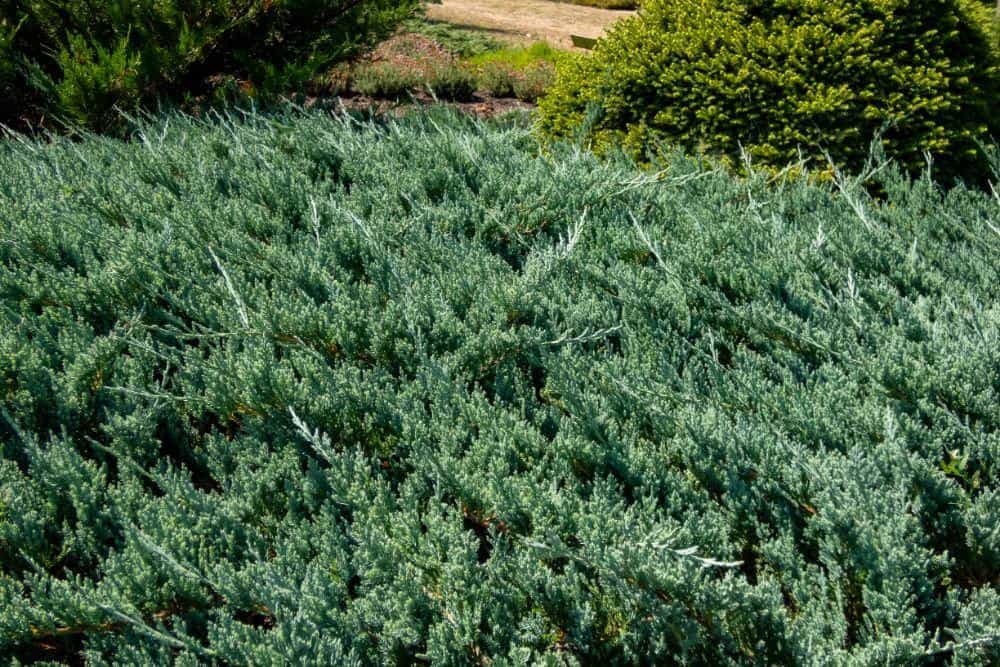
Creeping Juniper Covers a Lot of Ground Quickly and Does Well on Sloped Terrain to Mitigate the Effects of Erosion
Evergreen Foliage Varieties
Evergreen ground covers stay green year-round, providing consistent coverage. Pachysandra is a well-known evergreen that thrives in shady areas. It has glossy green leaves and spreads quickly, making it suitable for planting under trees. Note that pachysandra requires acidic soil – making many parts of the Front Range poor soil candidates for planting pachysandra.
Lilyturf is another evergreen option with grass-like foliage. It grows in clumps and produces purple flower spikes in late summer. Lilyturf is resilient and can handle various growing conditions. It does well in dry shade.
Hosta is not traditionally evergreen but acts similarly. With its large, attractive leaves, hosta provides excellent cover in shaded garden areas. It is also tolerant of various soil types.
Flowering Ground Covers
Flowering ground covers add color and interest to the landscape. Sweet woodruff is a charming option with its clusters of small white flowers in spring. It grows well in shaded areas and keeps weeds at bay. Sweet woodruff is also ideal for planting in large areas as it can quickly expand.
Stonecrop, or sedum, is another popular flowering ground cover. It comes in various types, including creeping varieties that produce tiny blooms in early summer. Stonecrop is heat and drought-tolerant once established.
Foliage-Focused Ground Covers
Hosta again stands out for its large, variegated leaves that provide vibrant garden coverage. Hosta is versatile and adapts well to shade.
Ajuga also fits into this category with its shiny, colorful foliage. Its leaves can range from deep purple to bronze, making it a striking addition to any garden. It does require at least partial shade – which can make it a challenge to incorporate into your garden or planting areas.
Drought-Tolerant Covers
Drought-tolerant ground covers require less water, making them ideal for dry climates. Stonecrop, or sedum, is a standout choice. Its fleshy, succulent leaves are built to retain water, and it performs well in rocky or sandy soils.
Creeping thyme is another excellent drought-tolerant option. It not only conserves water but also adds fragrance and color to gardens.
Lilyturf may also fit this category due to its adaptability to various soil moisture levels. Once established, it requires minimal watering and provides vibrant green foliage year-round.
Caring for Ground Cover Plants
Watering and Irrigation
Ground cover plants generally require less water than other plants. Initially, they need watering to establish roots. Once established, they are fairly drought-tolerant.
In dry periods, water deeply once a week to encourage deep root growth. Use drip irrigation or soaker hoses to deliver water directly to the root zone.
Avoid overhead watering to reduce the risk of leaf diseases. Always check soil moisture before watering, as too much water can lead to root rot.
Dealing with Invasive Species
Some ground covers can become invasive if not managed properly. Identify and monitor aggressive species like ivy or vinca. These plants can spread quickly and overtake other areas of the garden.
To control invasive ground covers, regularly check their boundaries. Remove any unwanted spread by pulling or cutting back the plants.
Consider installing weed barriers around garden beds to keep invasives in check. Effective management helps maintain balance without disturbing other garden plants.
Maintenance and Pruning
Regular maintenance is key to keeping ground cover plants healthy and attractive. Pruning helps control their growth and encourages dense, lush foliage.
Believe it or not, you can actually mow some ground covers. Mowing is suitable for ground covers like clover or thyme. Set the mower at the highest setting to avoid damaging the plants.
For other types, use sharp shears to trim back overgrowth, especially after flowering. Remove dead or diseased plant material to prevent the spread of pests and diseases.
Mulching and Fertilization
Mulching is essential for ground cover plants. It helps retain soil moisture, acts as highly effective weed control, and provides organic matter as it breaks down. Use organic mulch like compost or bark chips around the base of the plants.
Fertilize ground covers in early spring with a balanced fertilizer. Apply according to the product instructions to avoid over-fertilizing, which can lead to excessive growth and reduce their low-maintenance benefits.
Reapply mulch annually to maintain its benefits and support the growth of healthy, vigorous plants.
Incorporating Ground Covers Into Your Landscape
Design Considerations
When planning, it’s essential to match ground covers to the landscape’s conditions. Creeping phlox is ideal for rocky and sunny spots. Use low-growing plants along paths and stepping stones to create a cohesive look.
Ensure plants are suited to the environment’s light, water, and soil conditions. Shady areas require shade-tolerant species like hostas. Group plants with similar needs to simplify maintenance.
Vary heights and textures to create visual interest. Low-growing ground covers can be paired with taller shrubs and trees to create layered plantings.
Companion Planting
Ground covers can be combined with other plants to enhance the landscape. For example, creeping thyme works well under roses because it acts as a natural weed barrier and as an additional bonus, it adds fragrance.
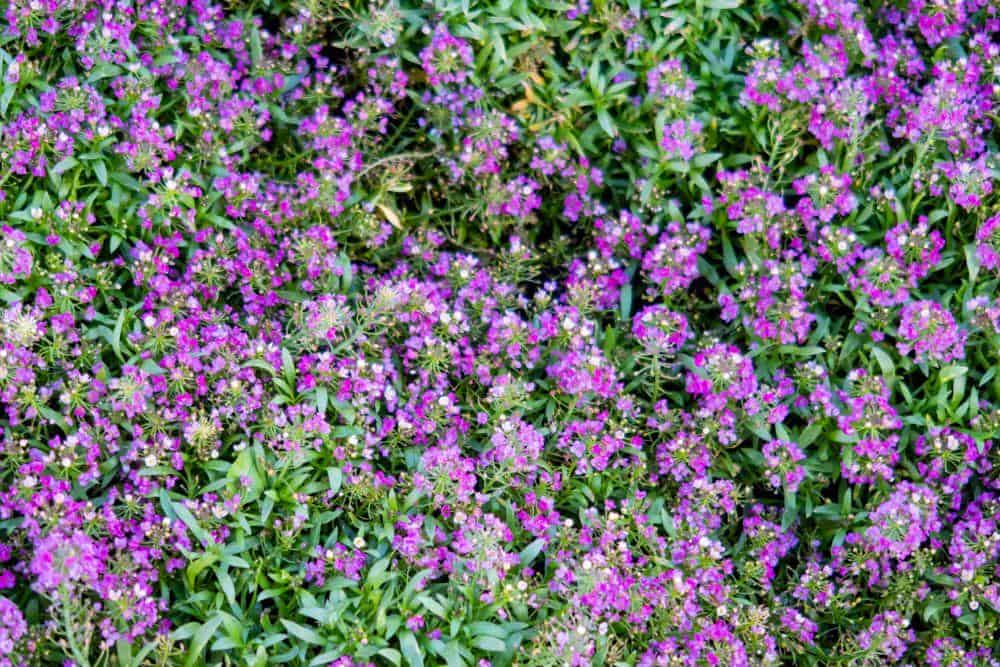
Creeping Thyme with Roses Makes for Wonderful Companion Planting
Plant ground covers around the bases of trees to protect roots and retain moisture. Choose species that won’t compete aggressively for nutrients.
Edging plants like ajuga can be planted along garden borders to prevent soil erosion and define pathways. When selecting companions, consider their growth habits to ensure harmony.
Ground Covers for Slopes and Hillsides
Sloped areas benefit from ground covers that control erosion and provide stability. Vinca minor is excellent for shady slopes, as it spreads quickly and holds soil.
For sunny inclines, juniper varieties are durable and low-maintenance. Planting ground covers on slopes reduces mowing needs and helps prevent soil loss during heavy rains.
Terracing slopes with retaining walls can create planting pockets for ground covers. This approach allows for the use of various species and makes the area easier to maintain.

